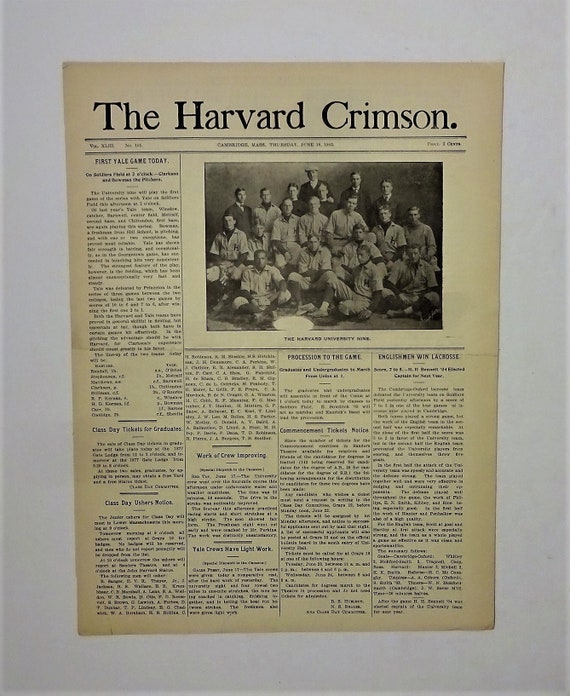When you think about college journalism, one name stands out like a beacon of excellence—the Harvard Crimson newspaper. For over a century, this iconic publication has been shaping the minds of students, challenging the status quo, and setting the benchmark for campus journalism across the globe. It’s not just a newspaper; it’s a legacy, a tradition, and a testament to the power of student voices.
Now, let’s get real for a sec. The Harvard Crimson is more than just ink on paper. It’s a platform where young journalists cut their teeth, where ideas are debated fiercely, and where the seeds of change are planted. If you’ve ever wondered why this newspaper is such a big deal, buckle up because we’re diving deep into its history, impact, and why it continues to be a cornerstone of campus journalism.
From its humble beginnings to its current status as a powerhouse in the world of student media, the Harvard Crimson has a story worth telling. Whether you’re a journalism enthusiast, a history buff, or just someone curious about the inner workings of campus life, this article’s got you covered. So, without further ado, let’s unravel the fascinating legacy of the Harvard Crimson newspaper.
Table of Contents
- The Rich History of the Harvard Crimson
- A Closer Look at the Newspaper's Biography
- The Impact of the Harvard Crimson on Campus Journalism
- Challenges Faced by the Harvard Crimson
- Notable Achievements and Milestones
- The Editorial Process: Behind the Scenes
- Transition to Digital Media
- The Legacy of the Harvard Crimson
- The Future of Campus Journalism
- Conclusion: Why the Harvard Crimson Matters
The Rich History of the Harvard Crimson
Let’s rewind the clock and take a trip down memory lane. The Harvard Crimson wasn’t always the mighty publication it is today. Back in 1873, a group of ambitious students decided that Harvard needed a voice—a platform where ideas could be shared, debated, and celebrated. And just like that, the Harvard Crimson was born.
Over the years, the Crimson has evolved, adapting to the changing times while staying true to its core mission of fostering critical thinking and promoting free speech. It’s not just about reporting the news; it’s about shaping the narrative and holding those in power accountable.
But here’s the kicker—the Harvard Crimson has always been student-run. That means no faculty advisors breathing down their necks, no corporate overlords dictating what gets published. It’s all about the students, for the students, and by the students. Now, isn’t that something worth celebrating?
A Closer Look at the Newspaper's Biography
Before we dive deeper, let’s take a moment to appreciate the biography of this legendary publication. The Harvard Crimson isn’t just a newspaper; it’s a living, breathing entity that has witnessed the highs and lows of campus life.
| Founded | 1873 |
|---|---|
| Location | Cambridge, Massachusetts |
| Publication Frequency | Daily during the academic year |
| Notable Alumni | John F. Kennedy, Barack Obama, and many more |
These stats are just the tip of the iceberg. The Crimson has been a breeding ground for some of the most influential journalists, politicians, and thinkers of our time. And that’s not even the half of it.
The Impact of the Harvard Crimson on Campus Journalism
So, why does the Harvard Crimson matter? Well, it’s simple. This newspaper has been at the forefront of campus journalism, setting the standard for what student-run publications can achieve. It’s not just about reporting the news; it’s about creating a culture of accountability, transparency, and critical thinking.
One of the biggest impacts of the Crimson is its role in shaping public opinion on campus. Whether it’s covering hot-button issues like social justice, climate change, or campus politics, the Crimson has a knack for sparking conversations that matter.
And let’s not forget the ripple effect. The Crimson’s influence extends beyond Harvard’s ivy-covered walls, inspiring other campuses to take journalism seriously. It’s a reminder that even the smallest voices can make the biggest impact.
Challenges Faced by the Harvard Crimson
Of course, no story is complete without its share of challenges. The Harvard Crimson has faced its fair share of hurdles over the years. From financial constraints to navigating the delicate balance between free speech and sensitivity, the Crimson has had to adapt and evolve.
- Financial Struggles: Like many student publications, the Crimson relies heavily on donations and advertising revenue. Keeping the lights on while maintaining editorial independence is no small feat.
- Censorship Concerns: There have been instances where the administration or external forces have tried to silence certain voices. The Crimson has always stood firm, refusing to compromise on its principles.
- Technological Shifts: With the rise of digital media, the Crimson had to rethink its strategy, embracing new platforms while staying true to its roots.
But hey, challenges are just opportunities in disguise. The Crimson has risen to the occasion time and time again, proving that resilience is one of its defining traits.
Notable Achievements and Milestones
Now, let’s talk about the good stuff—the achievements and milestones that have cemented the Harvard Crimson’s place in history. From investigative journalism that uncovered scandals to thought-provoking editorials that sparked national debates, the Crimson has left an indelible mark on the world of journalism.
Did you know that the Crimson was the first student newspaper to win a Pulitzer Prize? That’s right. And that’s just the tip of the iceberg. Over the years, the publication has received countless accolades, proving that quality journalism knows no bounds.
But it’s not just about awards. The Crimson’s impact is felt in the lives of its readers, its staff, and the broader community. It’s a testament to the power of student voices and the importance of holding those in power accountable.
The Editorial Process: Behind the Scenes
Ever wondered what goes on behind the scenes at the Harvard Crimson? It’s a fascinating process that involves a lot of hard work, collaboration, and dedication. The editorial team is made up of students from all walks of life, each bringing their unique perspective to the table.
Here’s a sneak peek into the editorial process:
- Idea Generation: Students pitch story ideas, brainstorming topics that matter to the campus community.
- Research and Reporting: Once an idea is greenlit, reporters hit the ground running, gathering facts, interviewing sources, and piecing together the story.
- Editing and Fact-Checking: The editorial team goes through the content with a fine-tooth comb, ensuring accuracy and fairness.
- Publication: Finally, the story is published, reaching thousands of readers both on campus and beyond.
It’s a labor of love, and the results speak for themselves. The Crimson’s commitment to quality journalism is unmatched, and it shows in every article they publish.
Transition to Digital Media
As the world went digital, so did the Harvard Crimson. The transition wasn’t easy, but it was necessary. In today’s fast-paced world, where news travels at the speed of light, having a strong digital presence is crucial.
The Crimson embraced this change with open arms, launching a website that offers breaking news, in-depth features, and multimedia content. They’ve also ventured into social media, using platforms like Twitter and Instagram to engage with their audience in real-time.
But here’s the thing—the Crimson hasn’t forgotten its roots. They still publish a print edition, recognizing the value of tactile journalism in an increasingly digital world. It’s a delicate balancing act, but one they’ve mastered with grace.
The Legacy of the Harvard Crimson
So, what’s the legacy of the Harvard Crimson? It’s simple yet profound. The Crimson has been a beacon of hope, a champion of free speech, and a catalyst for change. It’s a reminder that journalism matters—that the truth matters.
From its humble beginnings to its current status as a powerhouse in campus journalism, the Crimson has proven time and again that student voices have the power to shape the world. It’s a legacy worth celebrating and one that will continue to inspire future generations.
The Future of Campus Journalism
As we look to the future, the Harvard Crimson continues to lead the charge in campus journalism. With new technologies, evolving media landscapes, and a growing focus on digital storytelling, the possibilities are endless.
But the core mission remains the same—to foster critical thinking, promote free speech, and hold those in power accountable. The Crimson’s commitment to these principles ensures that it will continue to be a pillar of campus journalism for years to come.
And let’s not forget the importance of diversity and inclusion. The Crimson is working hard to ensure that all voices are heard, that all perspectives are represented. It’s a testament to their dedication to creating a more equitable and just world.
Conclusion: Why the Harvard Crimson Matters
As we wrap up this journey through the legacy of the Harvard Crimson newspaper, one thing is clear—it matters. It matters because it gives students a voice, because it challenges the status quo, and because it reminds us of the power of journalism.
So, the next time you pick up a copy of the Crimson or scroll through their website, take a moment to appreciate the hard work, dedication, and passion that goes into every article. And if you’re inspired, why not leave a comment, share the article, or even consider joining the staff? After all, the future of campus journalism is in good hands.
Let’s keep the conversation going. What do you think about the Harvard Crimson? Share your thoughts in the comments below and let’s continue to celebrate the power of student journalism.


